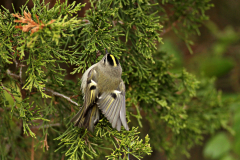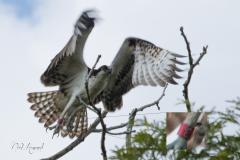Rare Species Sightings
How to report sightings of rare wildlife to the NJ Endangered and Nongame Species Program and re-sightings of banded birds.
 Zoom+ Golden-crowned kinglet, by youth second place winner Kayleigh Young.
Zoom+ Golden-crowned kinglet, by youth second place winner Kayleigh Young.
Reporting Rare Wildlife Sightings
One of the greatest threats to rare wildlife is loss of critical habitat. To help protect this crucial habitat, sightings of rare and imperiled species are used to identify habitat they need to exist. By reporting species sightings to the NJDEP Fish & Wildlife, Endangered and Nongame Species Program, you can help biologists build a picture of our state’s biodiversity. The most important sightings are of rare species during their breeding season.
The Endangered and Nongame Species Program has developed a new online application where the public can report rare species sightings. The NJ Wildlife Tracker app is a tool for submitting your sighting of rare species online, which also includes road-killed wildlife.
Please be prepared to provide the following information to help confirm your sighting:
- Species common and scientific name (if known)
- Type of observation (sighting, call heard, physical evidence, tracks)
- Date and time of sighting
- Location of the sighting shown on an aerial photo or Google map (coordinates)
- Land owner
- Description of the habitat
- Behavior of animal
- How the species was identified
- Your contact information
- Photos or video files for upload
Click here for more information and to access the NJ Wildlife Tracker app.
 Zoom+ On December 5th, 04/C was photographed on his wintering grounds of Trinidad and Tobago. He originated at a nest on Long Beach Island where he was banded with his two siblings, 05/C and 06/C. Ospreys spend their first two winters in their wintering areas. They learn the best foraging areas and will return to these same areas for the rest of their lives! © Nicholas Hassanali
Zoom+ On December 5th, 04/C was photographed on his wintering grounds of Trinidad and Tobago. He originated at a nest on Long Beach Island where he was banded with his two siblings, 05/C and 06/C. Ospreys spend their first two winters in their wintering areas. They learn the best foraging areas and will return to these same areas for the rest of their lives! © Nicholas Hassanali
Bird Band Re-sightings and Recoveries
Since the mid 1990’s the International Shorebird Team has placed colorful bands on thousands of shorebirds. Each band has a unique identifier and can be read with a good quality spotting scope. By sending in information from these banded bands, researchers and the public can identify where the shorebirds – red knots, semipalmated sandpipers, ruddy turnstones, and sanderlings – were banded and where they winter, breed, and stop over during migration.
The website allows anyone living along the flyway to submit data on resightings for these birds and contribute to an amazing scientific collaboration designed to protect these birds from further decline, and in the case of the red knot, imminent extinction.
Migratory bird bands, including aux. "field readable bands" should also be reported to: reportband.gov.




